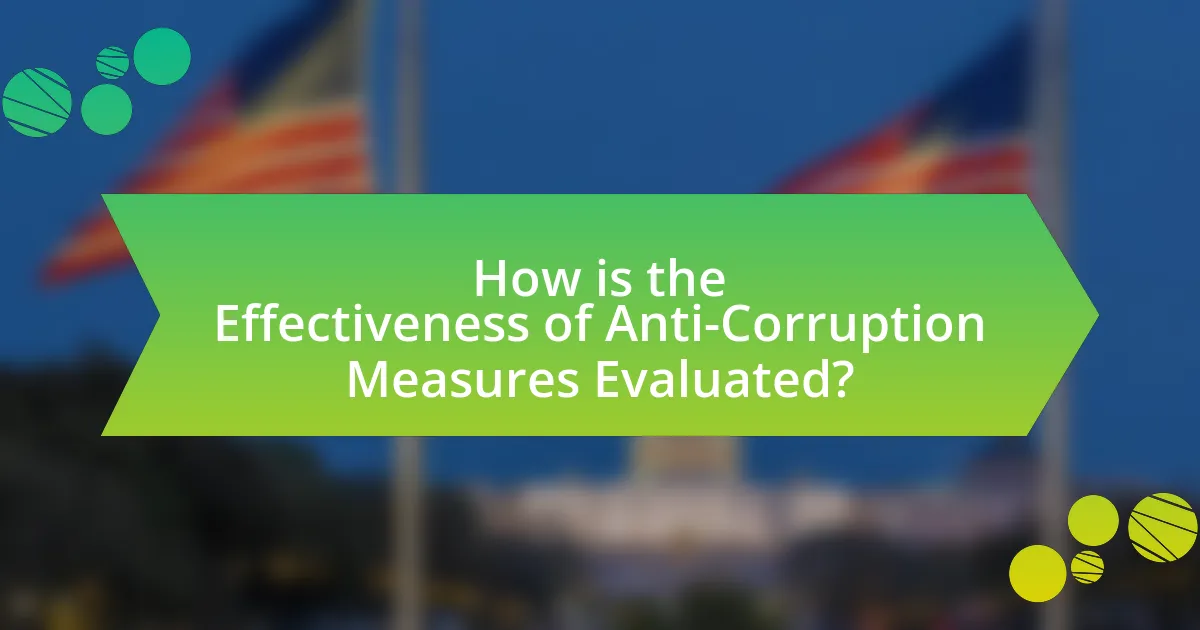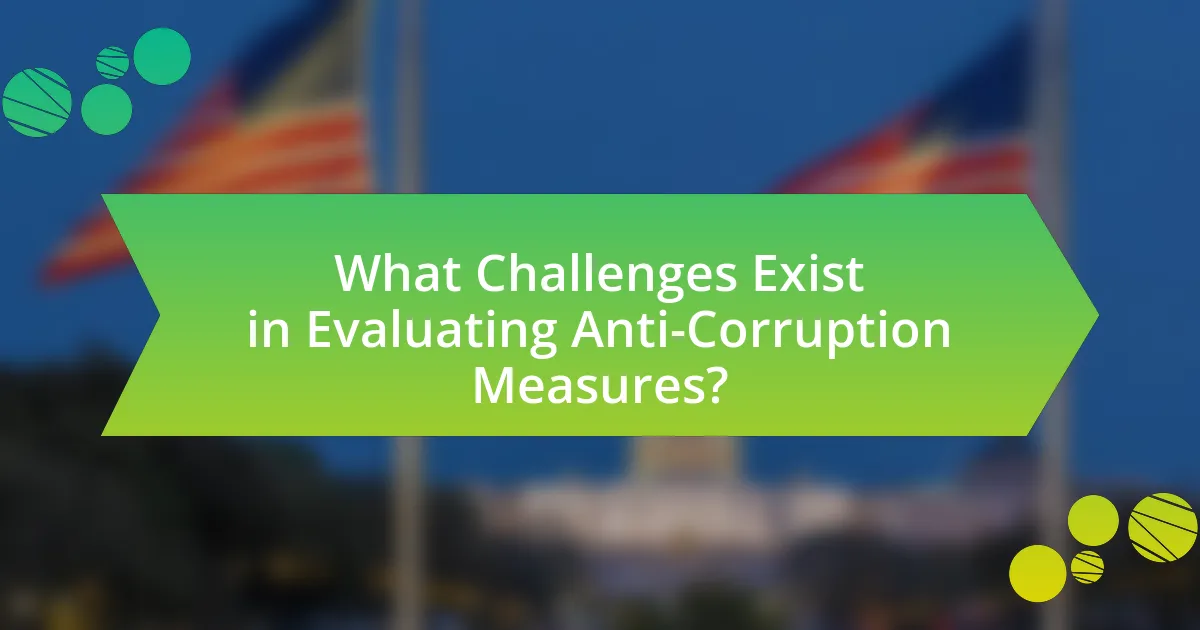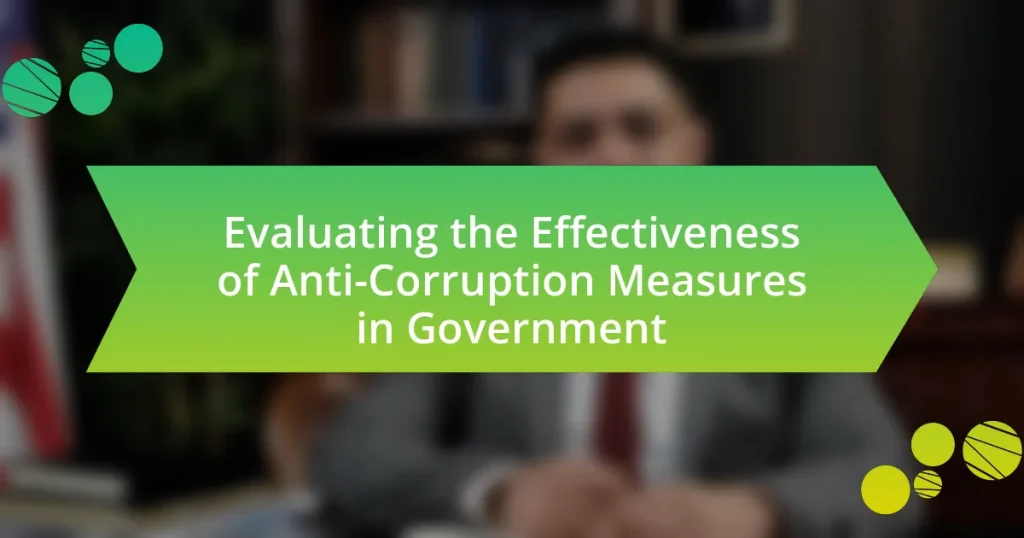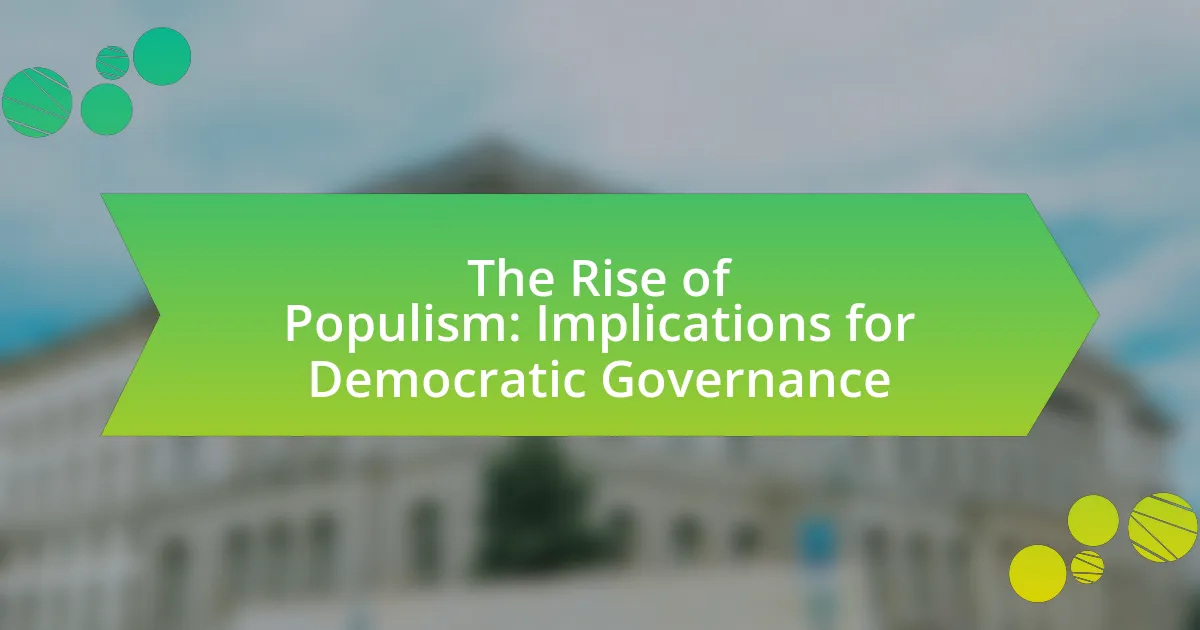The article focuses on evaluating the effectiveness of anti-corruption measures in government, which are essential strategies and policies aimed at preventing, detecting, and addressing corruption within public institutions. It outlines key components such as legal frameworks, transparency initiatives, and public engagement, and discusses how these elements interact to enhance accountability and reduce corruption. The article also examines the methodologies used for evaluation, including quantitative metrics and qualitative assessments, while addressing the challenges faced in measuring the impact of these measures. Furthermore, it highlights best practices for implementation, emphasizing the importance of transparency and public participation in fostering effective governance.

What are Anti-Corruption Measures in Government?
Anti-corruption measures in government are strategies and policies implemented to prevent, detect, and address corruption within public institutions. These measures include establishing legal frameworks, enhancing transparency through open data initiatives, implementing whistleblower protection laws, conducting regular audits, and promoting ethical standards among public officials. For instance, the United Nations Convention Against Corruption, adopted in 2003, emphasizes the importance of these measures by encouraging countries to adopt effective anti-corruption legislation and promote international cooperation. Additionally, countries that have implemented robust anti-corruption measures, such as Singapore, have seen significant reductions in corruption levels, demonstrating the effectiveness of these strategies.
How do Anti-Corruption Measures function within government systems?
Anti-corruption measures function within government systems by implementing policies and practices designed to prevent, detect, and address corrupt activities among public officials. These measures include establishing regulatory frameworks, enhancing transparency through open data initiatives, and promoting accountability via independent oversight bodies. For instance, the establishment of anti-corruption agencies, such as the Independent Commission Against Corruption in Hong Kong, has been shown to significantly reduce corruption levels by investigating and prosecuting corrupt practices. Additionally, the adoption of international agreements, like the United Nations Convention Against Corruption, provides a global standard for countries to follow, reinforcing their commitment to combat corruption effectively.
What are the key components of Anti-Corruption Measures?
The key components of Anti-Corruption Measures include legal frameworks, enforcement mechanisms, transparency initiatives, and public engagement. Legal frameworks establish the laws and regulations that define corrupt practices and outline penalties, ensuring accountability. Enforcement mechanisms, such as anti-corruption agencies and law enforcement bodies, are crucial for investigating and prosecuting corruption cases effectively. Transparency initiatives, including open government data and financial disclosures, promote accountability by allowing public scrutiny of government actions. Public engagement, through education and awareness campaigns, empowers citizens to participate in anti-corruption efforts and report corrupt activities. These components collectively enhance the effectiveness of anti-corruption measures in government.
How do these components interact to prevent corruption?
The components of anti-corruption measures, such as transparency, accountability, and enforcement mechanisms, interact synergistically to prevent corruption. Transparency allows citizens and stakeholders to access information about government actions, which fosters accountability by enabling scrutiny of officials’ conduct. When accountability is established, officials are more likely to adhere to ethical standards due to the fear of repercussions. Enforcement mechanisms, including legal frameworks and regulatory bodies, provide the necessary tools to investigate and penalize corrupt activities, thereby deterring potential offenders. This interaction creates a comprehensive system where each component reinforces the others, leading to a more effective prevention of corruption. For instance, countries with strong transparency laws, like Sweden, consistently rank high on corruption perception indexes, demonstrating the effectiveness of these interconnected components.
Why are Anti-Corruption Measures essential for governance?
Anti-corruption measures are essential for governance because they promote transparency, accountability, and integrity within public institutions. Effective anti-corruption strategies reduce the risk of misuse of power and public resources, which can lead to improved public trust and enhanced service delivery. For instance, according to the World Bank, countries that implement strong anti-corruption frameworks can experience up to a 20% increase in economic growth due to better allocation of resources and increased foreign investment. This demonstrates that anti-corruption measures not only safeguard democratic processes but also contribute to sustainable development and social equity.
What impact do these measures have on public trust?
Anti-corruption measures significantly enhance public trust in government institutions. When governments implement transparent policies and accountability mechanisms, citizens perceive a reduction in corruption, leading to increased confidence in public officials. For instance, a study by the World Bank found that countries with robust anti-corruption frameworks experienced a 20% increase in public trust levels. This correlation indicates that effective anti-corruption strategies not only deter corrupt practices but also foster a more trustworthy relationship between the government and its citizens.
How do Anti-Corruption Measures contribute to economic stability?
Anti-corruption measures contribute to economic stability by promoting transparency and accountability in government operations. When corruption is reduced, public resources are allocated more efficiently, leading to improved public services and infrastructure. For instance, the World Bank has reported that countries with strong anti-corruption frameworks experience higher levels of foreign direct investment, as investors seek stable environments with reduced risks of financial mismanagement. Additionally, anti-corruption initiatives can enhance trust in government institutions, which is crucial for fostering a conducive economic climate. This trust encourages citizen participation in economic activities and supports sustainable growth.

How is the Effectiveness of Anti-Corruption Measures Evaluated?
The effectiveness of anti-corruption measures is evaluated through a combination of quantitative and qualitative assessments. Quantitative assessments often involve analyzing corruption perception indices, such as Transparency International’s Corruption Perceptions Index, which ranks countries based on perceived levels of corruption. Qualitative assessments may include surveys and interviews with stakeholders, including government officials, civil society, and the public, to gauge the impact of anti-corruption initiatives. Additionally, the evaluation process may involve examining changes in legal frameworks, enforcement actions, and the overall integrity of public institutions. These methods provide a comprehensive understanding of how well anti-corruption measures are functioning and their effectiveness in reducing corruption levels.
What criteria are used to assess the effectiveness of these measures?
The criteria used to assess the effectiveness of anti-corruption measures in government include transparency, accountability, public trust, and measurable outcomes. Transparency is evaluated by the availability and accessibility of information regarding government actions and decisions, which allows for public scrutiny. Accountability is assessed through mechanisms that hold officials responsible for their actions, such as audits and legal frameworks. Public trust is measured by surveys and studies that gauge citizens’ confidence in government integrity. Measurable outcomes involve analyzing specific indicators, such as the reduction in corruption cases or improvements in governance rankings, to determine the tangible impact of the implemented measures.
How do quantitative metrics play a role in evaluation?
Quantitative metrics are essential in evaluating the effectiveness of anti-corruption measures in government as they provide measurable data that can be analyzed for performance assessment. These metrics, such as the number of corruption cases reported, the amount of funds recovered, and the rate of successful prosecutions, allow for objective comparisons over time and across different jurisdictions. For instance, a study by Transparency International found that countries with robust quantitative metrics in their anti-corruption strategies experienced a 30% decrease in corruption-related incidents over five years. This demonstrates that quantitative metrics not only facilitate accountability but also enable policymakers to identify successful strategies and areas needing improvement.
What qualitative factors are considered in the assessment?
Qualitative factors considered in the assessment of anti-corruption measures in government include the integrity of institutions, public perception of corruption, stakeholder engagement, and the effectiveness of communication strategies. These factors are essential as they provide insights into how anti-corruption initiatives are perceived and their impact on societal trust. For instance, studies have shown that public perception significantly influences the success of anti-corruption policies, as higher trust in government correlates with lower corruption levels. Additionally, stakeholder engagement ensures that diverse perspectives are included, enhancing the legitimacy and effectiveness of the measures implemented.
What methodologies are commonly used in evaluating Anti-Corruption Measures?
Common methodologies used in evaluating anti-corruption measures include quantitative analysis, qualitative assessments, case studies, and comparative analysis. Quantitative analysis often involves statistical methods to measure the impact of anti-corruption initiatives, such as surveys that assess public perception of corruption and its changes over time. Qualitative assessments focus on in-depth interviews and focus groups to gather insights on the effectiveness of specific measures from stakeholders. Case studies provide detailed examinations of particular instances of anti-corruption efforts, allowing for a comprehensive understanding of their outcomes. Comparative analysis involves evaluating different jurisdictions or time periods to identify best practices and lessons learned. These methodologies are supported by various reports and studies, such as the World Bank’s “World Development Report” and Transparency International’s “Corruption Perceptions Index,” which provide empirical data and context for evaluating the effectiveness of anti-corruption measures.
How do case studies contribute to understanding effectiveness?
Case studies contribute to understanding effectiveness by providing detailed, contextual analyses of specific instances where anti-corruption measures have been implemented. These analyses allow researchers and policymakers to observe the real-world impacts of these measures, including both successes and failures. For example, a case study on the implementation of transparency initiatives in a particular government can reveal how these initiatives influenced public trust and reduced corruption levels, as evidenced by measurable changes in corruption perception indices. By examining these specific examples, stakeholders can identify best practices, understand the conditions that lead to successful outcomes, and adapt strategies accordingly, thereby enhancing the overall effectiveness of anti-corruption efforts.
What role do surveys and public opinion play in evaluations?
Surveys and public opinion are critical in evaluations as they provide measurable insights into the perceptions and experiences of citizens regarding anti-corruption measures. These tools enable researchers and policymakers to gauge the effectiveness of implemented strategies by collecting data on public trust, awareness, and satisfaction levels. For instance, a study by Transparency International found that countries with higher public engagement in anti-corruption initiatives reported greater success in reducing corruption levels, highlighting the correlation between public opinion and the perceived effectiveness of such measures.

What Challenges Exist in Evaluating Anti-Corruption Measures?
Evaluating anti-corruption measures faces significant challenges, primarily due to the difficulty in measuring intangible outcomes such as changes in public trust and perceptions of corruption. These measures often rely on self-reported data, which can be biased or manipulated, leading to inaccurate assessments. Additionally, the complexity of corruption itself, which can vary widely across different contexts and cultures, complicates the establishment of standardized metrics for evaluation. For instance, the World Bank’s Governance Indicators highlight that variations in governance and corruption perceptions across countries can skew comparative analyses. Furthermore, the political environment can influence the implementation and evaluation of anti-corruption initiatives, as governments may resist transparency or accountability measures that threaten their power. These factors collectively hinder the ability to effectively evaluate the success of anti-corruption strategies.
What are the common obstacles faced during evaluations?
Common obstacles faced during evaluations of anti-corruption measures in government include lack of reliable data, resistance from stakeholders, and insufficient resources. Reliable data is often scarce due to inadequate record-keeping and transparency issues, making it difficult to assess the effectiveness of implemented measures. Resistance from stakeholders, including government officials and agencies, can hinder the evaluation process as they may fear exposure of inefficiencies or corruption. Additionally, insufficient resources, both financial and human, can limit the scope and depth of evaluations, leading to incomplete assessments. These obstacles collectively impede the ability to accurately measure the impact of anti-corruption initiatives.
How does political influence affect the evaluation process?
Political influence significantly affects the evaluation process by introducing biases that can skew results and undermine objectivity. For instance, when political leaders prioritize certain outcomes, evaluators may feel pressured to align their assessments with these expectations, leading to manipulated data or selective reporting. Research indicates that evaluations in politically charged environments often reflect the interests of those in power rather than an impartial analysis of effectiveness. A study by the World Bank found that evaluations influenced by political agendas can result in a 30% variance in reported outcomes compared to independent assessments, highlighting the detrimental impact of political interference on the integrity of evaluation processes.
What limitations exist in data collection for evaluations?
Limitations in data collection for evaluations of anti-corruption measures in government include issues such as data availability, reliability, and bias. Data may be scarce due to lack of transparency in government operations, making it difficult to obtain comprehensive information. Additionally, the reliability of data can be compromised by inconsistencies in reporting practices or the manipulation of data to present a favorable image. Bias can arise from the subjective nature of self-reported data, where individuals may underreport or misrepresent corrupt practices due to fear of repercussions or social stigma. These factors collectively hinder the accuracy and effectiveness of evaluations aimed at assessing anti-corruption measures.
How can these challenges be addressed to improve evaluations?
To address challenges in evaluating the effectiveness of anti-corruption measures in government, implementing standardized metrics and methodologies is essential. Standardization allows for consistent data collection and analysis, facilitating comparisons across different contexts and time periods. For instance, the World Bank’s Governance Indicators provide a framework for measuring governance and corruption, which can be adapted to specific evaluations. Additionally, engaging stakeholders, including civil society and affected communities, enhances the evaluation process by incorporating diverse perspectives and ensuring accountability. Research by the U4 Anti-Corruption Resource Centre highlights that participatory approaches lead to more comprehensive evaluations, as they capture the nuances of local contexts. By combining standardized metrics with stakeholder engagement, evaluations can become more robust and reflective of actual impacts.
What best practices can enhance the reliability of evaluations?
To enhance the reliability of evaluations, employing a mixed-methods approach is essential, as it combines quantitative and qualitative data to provide a comprehensive understanding of the effectiveness of anti-corruption measures. This approach allows for triangulation, which increases the validity of findings by cross-verifying data from multiple sources. Additionally, establishing clear evaluation criteria and using standardized measurement tools ensures consistency and comparability across evaluations. Research by the World Bank indicates that evaluations utilizing mixed methods yield more robust results, as they capture the complexity of social phenomena, particularly in governance contexts. Furthermore, involving stakeholders in the evaluation process fosters transparency and accountability, which are critical for the credibility of the evaluation outcomes.
How can stakeholder engagement improve evaluation outcomes?
Stakeholder engagement can improve evaluation outcomes by ensuring that diverse perspectives and insights are incorporated into the evaluation process. Engaging stakeholders, such as government officials, civil society organizations, and affected communities, enhances the relevance and accuracy of evaluation criteria, leading to more comprehensive assessments. For instance, a study by the World Bank found that evaluations involving stakeholder input are 30% more likely to yield actionable recommendations, as stakeholders provide context-specific knowledge that can identify potential biases and gaps in data. This collaborative approach not only increases the credibility of the evaluation but also fosters ownership and commitment to implementing the findings, ultimately leading to more effective anti-corruption measures in government.
What are the Best Practices for Implementing Effective Anti-Corruption Measures?
The best practices for implementing effective anti-corruption measures include establishing a strong legal framework, promoting transparency, ensuring accountability, and fostering a culture of integrity. A strong legal framework provides clear definitions of corruption and outlines penalties, which is essential for enforcement. Transparency can be enhanced through public access to information and open government initiatives, as evidenced by the Open Government Partnership, which has shown that transparency reduces corruption levels. Accountability mechanisms, such as independent audits and whistleblower protections, ensure that individuals and institutions are held responsible for corrupt actions. Additionally, fostering a culture of integrity through ethics training and leadership commitment has been shown to significantly reduce corruption, as demonstrated by the World Bank’s findings that organizations with strong ethical cultures experience lower corruption rates.
How can governments ensure transparency in their measures?
Governments can ensure transparency in their measures by implementing open data initiatives that make information accessible to the public. These initiatives allow citizens to view government spending, decision-making processes, and policy outcomes, fostering accountability. For instance, the U.S. government’s Data.gov platform provides access to a vast array of datasets, promoting transparency and enabling public scrutiny. Additionally, regular audits and independent oversight bodies can further enhance transparency by verifying that government actions align with stated policies and regulations. Studies have shown that increased transparency correlates with reduced corruption levels, as evidenced by the Transparency International Corruption Perceptions Index, which highlights the importance of open governance in combating corruption.
What role does public participation play in successful implementation?
Public participation is crucial for the successful implementation of anti-corruption measures in government. Engaging the public fosters transparency, accountability, and trust, which are essential for effective governance. Studies have shown that when citizens are involved in decision-making processes, there is a significant reduction in corruption levels. For instance, the World Bank reported that countries with higher levels of civic engagement experience better governance outcomes, including reduced corruption. This correlation underscores the importance of public participation as a mechanism for enhancing the effectiveness of anti-corruption initiatives.






